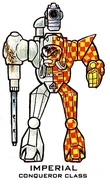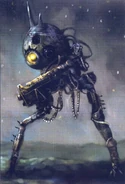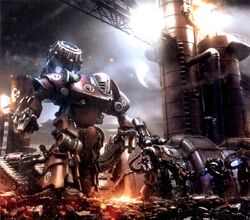
A cohort of Thanatar-class Heavy Siege Automata in combat during the Horus Heresy.
Imperial robots, known also as automata or battle-automata when they are used in combat, are non-sapient, mechanical automatons used for labour and combat within the Imperium of Man that were created as the result of the exploitation of now-lost archeotech intended to avoid the development of an Abominable Intelligence. They are primarily constructed and maintained by the Tech-priests who are members of the Legio Cybernetica, a sub-division of the Adeptus Mechanicus.
The Legio Cybernetica traces its origins to when early tech-savants experimented with artificial life during the Age of Technology. Ever curious, those early pioneers not only constructed vast hosts of automatons but also gave their creations the gift of independent thought.
That decision was to cost them dearly, and the rest of Humanity with them. After the terrible consequences of those times which resulted in the great machine uprising against Humanity of the Cybernetic Revolt, the dread concept of the Silica Animus, a self-aware machine, was outlawed forever, its creators subjected to excommunico fatalis and its resurrection punishable by torture to the point of death.
And yet there were those that still yearned to walk in their shadow, to perfect a thinking machine in the likeness of a Human mind. In lieu of creating automata with the souls of men, many recidivist Tech-priests created machines imbued with the animus of loyal beasts -- or worse, with essences from the Empyrean. This too had disastrous consequences.
The resultant schism was exploited by Horus himself when he betrayed the Emperor. Its legacy survived with the Dark Mechanicum, whose members still go to infernal lengths to give life to their machines. Many later-pattern robots are tainted by their association with the machine-predators of that desperate age.
So it is that in the 41st Millennium the animalistic Thanatar, Castellax and Vorax Patterns of Battle-Automata are forgotten on all but the most intrepid and independent of Forge Worlds, and the Dark Mechanicum spoken of only in whispered code. Yet the fear and dark legend of those unstoppable robot armies lives on.
Yet, over the millennia since the Horus Heresy, the Legio Cybernetica has regained the respect and admiration of the rest of the Adeptus Mechanicus as well as the other myriad adepta of the Imperium, though in fact it has rarely been deployed in recent centuries.
History
Origins
The origins of the robots employed by the Imperium harken back to the earliest days of Human technology, with the most advanced models presumably dating to the Dark Age of Technology during the zenith of Mankind's scientific prowess and technological power.
Not much is known of this bygone age due to the loss of so much advanced Human technology with the oncoming of the Age of Strife, but what is known is the ancient Mechanicum's Legio Cybernetica manufactured and produced large quantities of robots during the Great Crusade of the late 30th Millennium.
These robot cohorts were instrumental in helping to bring untold numbers of rediscovered Human-settled worlds back into the fold of Humanity and under the rule of the Emperor of Mankind. The Imperial conquest continued nearly unabated for over two standard centuries until the realm of the Emperor was threatened by an unforeseen and unexpected threat from within with the onset of the terrible interstellar civil war known as the Horus Heresy.
Horus Heresy
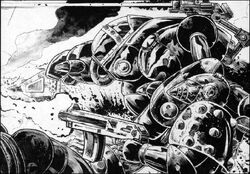
A cohort of Castellan-class robots fight alongside the Space Marines during the Horus Heresy.
Warmaster Horus, the primarch of the Luna Wolves Legion, was one of the twenty superhuman, genetically-engineered sons of the Emperor created to lead the armies of the Great Crusade in their great task of reuniting all the Human-settled worlds of the galaxy beneath the rule of the Imperium.
He was the Emperor's right hand; his greatest and most beloved son. He knew he would have to secure the support of the ancient Mechanicum and their superior technology and materiel if he was to defeat the Emperor and conquer the galaxy once he had decided to rebel.
Taking advantage of the climate of discontent already present within the Mechanicum over restrictions the Emperor had placed on the development of certain advanced technologies like artificial general intelligence and all Warp-based technologies, the Warmaster manipulated the ruling Fabricator-General Kelbor-Hal of Mars and his loyal followers into joining his cause and founding what would later be known as the Dark Mechanicum.
This included many Tech-adepts of the Legio Cybernetica, who were some of the first to declare for the Warmaster and follow him into treachery against the Emperor. The terror value of robots when used against unprepared and underarmed troops had not gone unnoticed by the Warmaster. This, combined with their unflagging loyalty, had made them an invaluable addition to his expeditionary fleet when bringing worlds into Imperial Compliance during the Great Crusade.
When Horus commanded his forces to move against the Emperor during the opening days of the Heresy, many of the Legio Cybernetica cohorts at his disposal leapt to obey.
When the conflict ended following the defeat and death of Horus at the hands of the Emperor during the Siege of Terra, these dishonoured cohorts of the Legio Cybernetica fled into the dark realm of the Eye of Terror alongside the Traitor Legions, where they remain to this day. In their wake those cohorts of the Legio Cybernetica that had remained loyal were viewed with great suspicion within the reorganised Adeptus Mechanicus, and would be rarely deployed in the millennia to come.
Components
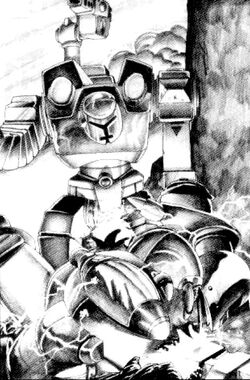
A Traitor Colossus-class robot faces off against a Loyalist Castellan-class robot during the Horus Heresy.
A robot, like an Astartes Dreadnought, is the product of the synthesis of multiple advanced technologies required to construct its armoured shell, artificial muscle and nerve bundles, power plant, weapons control systems, equipment interfaces and central neural cortex.
The forges of the Adeptus Mechanicus turn out many robots of the age-old designs stored within the core memory of their logic-stacks. For example, both the Castellan and Crusader pattern robots are known to have fought on the side of both Loyalists and Traitors during the Horus Heresy. The designs have remained virtually unchanged since that time, with perhaps only minor cosmetic differences and variations.
The compatibility of the near-identical robotic components shared with the Dreadnought simplifies many supply and repair problems on the battlefield. It is not unknown for Legio Cybernetica robot cohorts to have been cannibalised out of existence to provide spare parts for Dreadnoughts.
In return, Legio Tech-adepts have not been adverse to dismantling Dreadnoughts, sometimes killing its Astartes occupant in the process, when making battlefield repairs.
As might be imagined, such actions are not well-regarded by any Space Marine Chapter which should catch a Legio Tech-adept actually killing a Dreadnought battle-brother to save his or her mechanical "pets."
Cortex and Programming
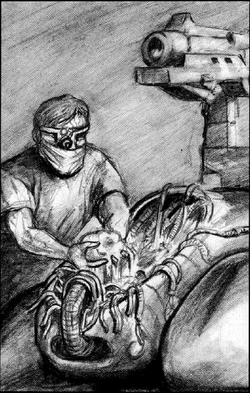
A Legio Cybernetica Tech-adept performing routine maintenance on a Castellan-class robot's neural cortex.
Constructed from artificially engineered neuroproteins and enzymes, the neural cortex is the artificial brain of an Imperial robot. Imprinted with simple maintenance, task and movement algorithms, the cortex serves as a rudimentary mind, enabling the robot to obey simple instructions from its assigned Tech-adept when away from the battlefield.
These "firmware" routines are often patterned after those which exist in the organic neural cortexes of simple living creatures. It is known that an Imperial robot commonly develops a canine-like devotion to its technician-master.
Before deploying a robot into battle the firmware routines are overlaid and replaced with so-called "wetware"; this is the robot's combat software which defines the commands of its handler. For example, wetware contains a set of algorithms that tell a robot where it is to deploy on the battlefield or when to fire its weapons or detonate its self-destruct charges.
This specialised software is held in small slices of bioplastic, no larger than a credit card, which have been implanted within the robot's cortex. Believed by the Tech-priests of the Adeptus Mechanicus to hold the robot's "soul", its Machine Spirit, many warriors on the battlefield are known to take these small bioplastic cards from a "dead" robot that has been incapacitated. They believe that by doing so, some of the robot's bravery will pass onto them. Even some Adeptus Astartes Chapters have been known to abide by this tradition.
In many situations a robot may be less effective than a living warrior, even though its reflexes and aim may be comparable, and it is a stronger, tougher and harder opponent to "kill" than a Human soldier. Yet, literal-minded to an inhuman degree, a robot is limited by its programming.
Whatever the given situation, a robot always follows its pre-prepared programming, even when such programming will not produce the correct outcome for a given situation. Where a Human can easily adapt to unexpected developments, a robot may not possess the mental adaptability required to successfully navigate the demands of a rapidly changing battlefield.
Like any other weapon system, a robot without its cortex is as useless as a bolter without its Space Marine. Without an operational cortex the robot is merely a heap of junk that can only take whatever punishment is meted out to it, but with a fully programmed cortex, a robot can prove itself the equal of many other opponents on the battlefield.
Slave and Master Systems
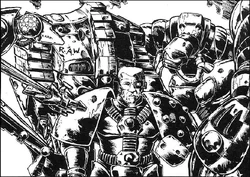
A Techmarine operator of the Desert Lions Chapter and his maniple of Imperial Robots.
In some situations robots do not need a neural cortex to be fully operational, as they also possess the ability to act as the "slave" of a "master" robot, receiving orders by wireless vox communication from the master robot. The master robot is fitted with a neural cortex and wetware program, which in turn, relays algorithmic instructions to the slave robots fitted with standard vox communicators.
Each of these slave robots follows the instructions of the master's program in turn. But the master robot must remain in close proximity to its slave robots, for if it were to move beyond the effective range of its vox transmitter the other robots would simply freeze in place, lacking the necessary instructions to carry out any operations.
Should six or more of its communicator signals be jammed, a slave robot cannot perform any actions, and will freeze in place until further instructions are received. If the master robot's program or cortex are damaged all of its slave robots are affected equally.
Communicator damage to a slave robot means that it can no longer receive or transmit data, grinding to an immediate halt. Any damage to a master robot's vox transceiver brings all its slave robots to a halt. Any other damage to the master robot's other systems has no effect on its slaves.
Any number of slave robots can be controlled by a single master robot, although the usual ratio is 1 master to 3 slaves. When a larger ratio is used, damage to a master robot's program can halt too many slave robots in a single stroke.
Doctrina Wafers
Since the aftermath of the Warmaster Horus' rebellion the Legio Cybernetica's robots have been controlled completely by their masters -- not by the bio-plastic cerebra and nerve-like tendril webs of the ancient Mechanicum's constructs, but by sanctified doctrina wafers.
No bigger than the cards of the Emperor's Tarot, these slivers of wetware are entrusted to the Cybernetica Datasmiths that accompany the Adeptus Mechanicus' robot maniples to war. Inserted into the data-slot hidden behind each robot's chestplate, the wafer's command protocol will dictate every iota of the host's behaviour, usually optimising its ability to destroy its foes in a spectacular fashion.
Should a robot be controlled by a Protector Pattern doctrina wafer, it will concentrate its efforts towards ranged combat, mowing down rank upon rank of the enemy with an accuracy a mere Human could never hope to match. If the accompanying Tech-priest wishes to change the behaviour of their charges -- for instance to the assault-oriented Conqueror Pattern protocol -- they must manually remove the first doctrina wafer and insert a new one in its place.
Many patterns of doctrina are in shorter supply than the robots themselves. Though there are dozens of robot clades and anatomies, each is entirely mechanical, and hence easier to maintain than the fusion of bio-matter and electronics that forms each doctrina wafer.
Furthermore, whenever a maniple of robots finds itself in battle mode without an escorting Cybernetica Datasmith, it will continue to prosecute its last doctrina protocol until it runs out of power -- something that usually takes solar weeks of unbridled slaughter to achieve.
Such risks and limitations are willingly accepted by the Cult Mechanicus, for the act of hardwiring independent thought into a battle-automata is strictly forbidden. Yet none know how many maniples the Legio Cybernetica could field if the ancient prohibition on artificial life and thinking machines was lifted.
Imperial Robot Types
Over the centuries the Legio Cybernetica has produced many robot designs. Many proved to be successful, and the Legio has kept the five most common Imperial battle robot patterns in its inventory for most of the Imperium's long and bloody history.
Some of these designs were utter failures, such as the disastrous Castigator-class, which was so heavily armoured it moved slower than the troops it was designed to protect and support. Its survival capability was negligible as it was only outfitted with meagre weapons -- a single bolter.
Robot Patterns
- Baharat- The Baharat-class robot was designed for battling many unarmored foes at once. Standing at four metres tall, it is a mass of metal and muscle with two shoulder-mounted rotary Autocannons, its featureless facemask looking down upon its foes as it mows them down with an unrelenting barrage.
- Castellan - The Castellan-class robot was designed for general-purpose combat and assault and is also ideally suited for a wide-range of battlefield situations. It is armed with a Power Fist on each arm as well as a Heavy Bolter mounted above its chassis for additional protection and ranged firepower. This standard configuration makes it particularly effective in siege and anti-vehicle roles, and provides an effective compliment to heavy weapon armament.
- Castellax - The most common pattern of the widespread Castellan-type Battle-Automata in service, the Castellax is a general battle unit developed during the Great Crusade from its ancient forebear. Primarily intended for siege work and shock assaults, the Castellax Battle-Automata is a hulking humanoid machine with a notoriously aggressive and responsive Machine Spirit, and an enviable reputation on the battlefield. The Castellax, employed in units of one to five by the Legio Cybernetica, has a standard configuration of bolter and Bolt Cannon armament, and is able to maintain a punishing barrage of firepower as it advances.
- Castellax-Achea - Never ones to squander their Legion's ranks in bloody attrition or vainglorious frontal assaults, the Thousand Sons Legion, and indeed their primarch Magnus the Red, had long acknowledged the usefulness of the unliving might of Battle-Automata as obedient, resilient and ultimately expendable shock assault units. As with every other facet of warfare, the use of such Battle-Automata was something the Thousand Sons believed they could improve upon with the application of their psychic arts as a method of control and perhaps direct augmentation, freeing them potentially from the need for the techno-arcane lore of the ancient Mechanicum to be directly called up in these machines' construction and fielding. That such research had long been considered a "heretek anathema" to the Mechanicum was a factor ignored, as was so much else in the Thousand Sons' hubris, and with the assistance of near-Renegade elements from the isolated Forge World of Zhao-Arkhad, their early experiments had yielded fruit in the form of a custom-designed Castellax variant of their own specifications in the last years before their censure. Designed to be psychically responsive with a certain degree of self-will, eliminating the necessity for cortex controller-equipped superiors, the Castellax-Achea Pattern utilised a crystalline cogitator matrix charged with an intricate web of psychic energies woven from the stuff of the Immaterium. Pure tech-blasphemy according to the doctrines of the Omnissiah and the laws of the Imperium both, these esoteric devices give the Castellax-Achea the ability to be seamlessly manipulated like puppets under a psyker's remote control, and a limited self-will, allowing it to recognise friend from foe with reasonable accuracy when not under direction.
- Cataphract - The Cataphract-class robot is a heavily-armoured, general-purpose battle robot designed for use in almost all combat environments and situations. This versatility in a wide range of battlefield roles makes this war engine a highly-deployable and popular machine among the Legio Cybernetica's cohorts. This robot can mount a variety of weapons for various purposes, the most common being one lascannon above its chassis and a bolter mounted on one arm and one Flamer mounted on the other. It is often regarded by some Imperial commanders as a jack-of-all-trades.
- Colossus - The Colossus-class robot was designed to function primarily as a siege weapon. Its standard configuration combines a Siege Hammer mounted one of its arm appendages for attacking fortifications with a bolter mounted on its other arm appendage for use against defending troops. The Siege Hammer can also be used in close combat situations. It also possesses a chassis-mounted Multi-Melta for additional firepower. The Colossus is often employed by the Astra Militarum as a cheap alternative to the use of heavy artillery. A few Colossus-class robots are maintained by the Ordo Reductor of the Adeptus Mechanicus, mainly for testing new and experimental siege weaponry.
- Conqueror - The Conqueror-class robot was designed for use in battlefield situations where heavily-armed resistance is expected. Its combination of potent firepower combined with heavy armour is a major benefit of its design. On one of its arms is mounted an Autocannon, on the other a Power Fist. Above its chassis is mounted a Heavy Bolter for additional firepower. The Conqueror is ideally suited for assault, anti-vehicle and anti-Dreadnought roles on the battlefield.
- Arlatax - The Arlatax Pattern was a venture of the Xanite Mechanicum to improve upon the ancient Conqueror Pattern STC-derived robot and whose development is believed to have heavily influenced the final design-schematics of the later Domitar Pattern. Suspicious from the start of this new development of the priesthood of Xana II, the Priesthood of Mars never cleared the Arlatax for mass-production, and so this pattern only saw use within the Taghmata forces of its home Forge World of Xana II and other outlying Forge Worlds such as Atar-Median and Incaladion.
- Domitar - Accorded by most observers to be the last class of Battle-Automata to enter production on multiple Forge Worlds before the outbreak of the civil war of the Horus Heresy, the Domitar was a sophisticated variant of the ancient Conqueror Pattern. Larger than the more common Castellax alongside which it would serve, the Domitar was also swifter, designed to cross the open battlefield at speed, and built expressly to crash into the enemy with shattering force. To this end the Domitar's shock-protected and armoured frame was itself a weapon, while its blows were amplified to colossal proportions by the Battle-Automata's built-in Graviton Hammers, allowing it to pulverise battle tanks and, as it would later prove, even Legiones Astartes Dreadnoughts in combat. As a line-breaker, the Domitar was unparalleled in the ancient Mechanicum's arsenal, and its tactical flexibility was further augmented with a Missile Launcher armed with a variety of munitions.
- Domitar-Ferrum -The Domitar Ferrum Pattern was a notable evolution of the initial Domitar-class that saw exclusive use within the ranks of the Iron Warriors Legion. Following the Battle of Phall, when the flagship of the IV Legion, the Iron Blood, came under attack by the Imperial Fists and a kill-squad actually managed to break through and threaten Primarch Perturabo, the Lord of the Iron Warriors modified six Domitar-class Battle-Automata to form his personal honour guard, which quickly earned the moniker of the "Iron Circle." The Domitar-Ferrum Pattern had been thoroughly modified by the hands of the primarch himself and incorporated many technologies not available to the ancient Mechanicum. For instance, the Domitar-Ferrum replaced its built-in Missile Launcher with a shoulder-mounted Olympia Bolt Cannon, a weapon believed to have been developed by Perturabo from the Castellax-class Battle-Automata's Mauler Pattern Bolt Cannon. More importantly, being intended for use as untiring and ever vigilant bodyguards for the primarch himself, the Ferrum Pattern eschewed the use of both its Graviton Hammers for a single Graviton Maul and a great Karceri Battle Shield, a massive Storm Shield adapted to the colossal size of the Domitar-Ferrum. Throughout the wars of the Horus Heresy, Pertuarbo steadily modified a great quantity of Battle-Automata, so that maniples of the Domitar-Ferrum could readily be encountered across several battlefields, the towering robots acting as protectors and executioners of the primarch's will.
- Crusader - The Crusader-class robot is designed for agility, as it can move quickly on the battlefield and strike a telling blow. It is a light combat robot, and it is poorly armoured. It is most often employed in an anti-personnel mode, and has proven to be very popular with the forces of the Inquisition and other groups like the Adeptus Arbites, due to its effectiveness in mutant-hunter/killer operations. The Crusader is never used where heavy resistance or strong concentrations of enemy armour are expected. The Crusader is typically armed with dual Power Swords on each arm, and a chassis-mounted Lascannon.
- Vorax - The Vorax-class Battle-Automata is a hunter-killer unit created from the ancient and revered Crusader template pattern said to date back to the Dark Age of Technology and which may be found on every major Forge World in the Imperium. Created on pre-Imperial Mars to fulfil the roles both of search and destroy weapon and exterminator of rogue thinking machines, servitors and mutant vermin, their Cybernetica cortex engrams are known to be particularly predatory and vicious examples of their kind. Such are the bestial instincts that sleep within their blast-steel and ceramite bodies that numerous cut-outs and override cantos are hard-wired into their control programming to prevent these tireless hunting machines from devolving into becoming like the renegade thinking machines they prey upon in the shadows of the great forge-fanes on Mars. Armed with a pair of Rotor Cannon and a Lightning Cannon, the Vorax are prepared to meet most threats. At close quarters their battle-automata power blades make short work of even heavily-armoured infantry units.
- Kastelan - A huge, ancient robot class first built ten thousand standard years ago, the Kastelan robot is a perfect example of the Adeptus Mechanicus' repurposing of technology. Nearly unstoppable, their only flaw is that of any mere machine: they will follow instructions to the letter, even if this results in their own demise. A specialist Tech-priest -- the Cybernetica Datasmith -- must constantly update and reprogram the Kastelan via order data-slates, lest this enormous, clanking robot simply stride blindly into a nearby chasm. Make no mistake, however; when its controls are set to destroy, the Kastelan will eliminate whatever lies in its path. Kastelan robots are armed with multiple potential weapon load-outs, such as two sets of Power Fists or a pair of twin-linked Phosphor Blasters, and a choice of carapace-mounted weaponry, either an Incendine Combustor or yet another Phosphor Blaster.
- Scyllax-Guardian - No larger than an armoured man, the Scyllax Guardian Automata demonstrates formidable power in a more compact frame. These sophisticated machine-creatures are neither a true Battle-Automata, lacking a cybernetic neural cortex, nor are they a true servitor-class automata as their organic component is almost negligible, reduced to the ossuary skulls and Human neural tissue harvested from sources best left unknown. Their armoured carapaces, as durable as Adeptus Astartes battle-plate, house instead powerful electrothermic reactors and banks of lucid cogitator-stacks that process a storm of battlefield analysis engrams and protective tech-incantations, a system so potent some claim it borders on the blasphemy of the Silica Animus. Prized far beyond the servo-automata from which they were developed using ancient secrets uncovered during the Great Crusade, Scyllax are found in the retinues of only the highest ranking magi, where they serve as bodyguards and elite shock troops. Though there are some factions within the Adeptus Mechanicus who will have no truck with the Scyllax, claiming sinister provenance for its design, and that the Automata gain a subtle and dangerous self-awareness over time.
- Thanatar - The Thanatar-class Siege Automata is a heavy class Imperial robot utilised by the Legio Cybernetica during the Great Crusade and Horus Heresy eras. Designed as a mobile artillery platform rather than a general battle unit, it is armed with a Hellex Pattern Plasma Mortar. This is a terrifying weapon able to launch dense spheres of blazing plasma on arcing trajectories over defensive barriers and into the heart of enemy fortifications, incinerating anything in their blast radius with a liquid tide of sun-hot fire. The Thanatar's frame, built to accommodate the huge weapon and the power systems and fuel reserves required to supply it, is considerably larger than even the hulking Castellax-class Battle Automata. Its frame is also heavily reinforced, both to withstand the stresses of firing its principal weapon and to protect it from incoming attacks. This factor, alongside the use of an Atomantic Shield array, make Thanatars notoriously durable. Such is their resilience that Thanatars are beyond the ability of most small arms, no matter how advanced, to harm. It is not known if this particular class of heavy-siege Automata is still utilised by the mysterious Legio Cybernetica in the late 41st Millennium.
- Thanatar-Calix - A variant of the Thanatar-class Siege-Automata developed during the latter part of the Great Crusade, rumours persisted that this extraordinarily powerful variant of the Thanatar was the work of the combined efforts of the Sollex Myrmidon and Omega-Shevar covenant of the Ordo Reductor, alongside unknown representatives of the Legio Cybernetica. The Thanatar-Calix combines the deadly tech-arcana of all three of these secretive ancient Mechanicum factions into a single, devastating weapons platform geared towards the vanguard of siege assault warfare, able both to sunder the strongest fortifications in moments and conduct targeted strikes to neutralise defensive batteries or turret emplacements with the lethal fire of its Sollex Heavy Lascannon. These rare Siege-Automata were held as sacred by the Mechanicum Taghmata and Ordo Reductor covenants which fielded them, as well as signs of particular prestige within the Cult Mechanicus, and were seldom committed to battle without supporting escorts of lesser Battle-Automata and Guardian-Automata in the field to protect them in their perilous duties.
- Thanatar-Cynis - Unlike the lauded Thanatar-Calix, this variant of the potent Thanatar-class Siege Automata, known as the Cynis, was met from its creation by the magi of Estaban III with ill-fortune and acrimony. An unashamed attempt by the Mechanicum faction on Estaban to increase their power within the order of the Machine God's domains, the Cynis was intended to replicate the Thanatar Siege-Automata on a wider scale. By doing so, the magi of Estaban perhaps hoped to further usurp the sometimes troublesome Forge World of Ryza's importance in the eyes of the fabricator-general of Mars. Without Ryza's mastery of plasma-arcana however, the Cynis proved an unstable and often self-destructive design, despite its obvious battlefield power; its Machine Spirits were equally believed to be erratic and malevolent by those adepts whose task it was to tend them. Regardless, the fabricator-general approved its design over the strong objectives of Ryza, worsening the feud which had broken out between Ryza and Estaban III, although the production of the class was far less successful than hoped. Accusations of sabotage and malifica by the magi of Estaban III on the covert agents of Ryza were commonplace before the outbreak of the Horus Heresy, and when Estaban III declared for the Traitors and Ryza the Loyalists, bitter blood could at last be settled with iron and fire.
- Vultarax - Although most Battle-Automata are land-based, the Adeptus Mechanicus also makes use of flying Battle-Automata, or Stratos Battle-Automata in the nomenclature of the Taghmata Omnissiah. The Vulturax Pattern Stratos Battle-Automata was the most common of these flying robotic units at the time of the Great Crusade. The design had originally been developed during the Age of Strife on the Forge World of Anetarbraxus which was later destroyed in the Great Mandragoran Incursion. Fortunately for the Adeptus Mechanicus, the Vulturax's schematics had been gifted as a tribute to the Martian Mechanicum which would disseminate the design throughout its domains. The Vulturax Stratos Battle-Automata is a powerful and well-armed flying machine capable of fulfilling diverse battlefield roles such as heavily armed scout, dedicated hunter-killer or rapid response unit. This versatility made the design quite popular amongst Mechanicum Explorator expeditions. Many Imperial scholars have also remarked upon the many similarities the Vulturax shares with the Daemon Engines later known as Blight Drones.
- Other Classes - The Legio Cybernetica also operated many other classes of Battle-Automata, including the Lamba Zeta-01 Combat Class Robot, the Delta Omega-03 Combat Class Robot, and the Rho-Tau 17 Surveillance Class Robot.
Organisation
Cohorts
Once employed by the forces of the Imperial Army and the Space Marine Legions, robotic cohorts are now exclusively used by the Legio Cybernetica. In ages past, the Legio Cybernetica was organised into several thousand cohorts, although only a small percentage of these were ever active at any given time.
Each of these robot cohorts were in turn organised into maniples of 3, 4 or 5 robots led by a Legio Cybernetica Tech-adept. Numbering rarely more than 100, the number of maniples within a cohort could greatly vary. However, a cohort was usually spread across an entire Astartes force of several companies or a single large Imperial Army force.
The use of more than 4 or 5 maniples in a battle was rare, but not unknown. During the Horus Heresy, particularly large numbers of robots were committed by both the Loyalists and Traitors in an effort to minimise Human casualties until a decisive final battle could be fought. In addition, the organisation was further divided into a number of sects.
A few of the ancient Legio Cybernetica cohorts claim that their robotic war engines date, in part at least, back to the Great Crusade or possibly even before to the Age of Strife. As robots are often cannabalised to provide spare parts for their damaged brethren, there may be some validity to these claims.
When properly maintained, the lifespans of Imperial technologies can span many Terran millennia. It is indeed possible that a robot's leg, arm, or cortex has been in constant use for ten thousand Terran years or more.
Maniples
A Legio Cybernetica maniple is a virtually self-contained unit, with a single Tech-adept or Cybernetica Datasmith typically overseeing the management of four units on the battlefield. The Tech-adepts do little more than give the robots their final wetware programs and then monitor their progress. However, they are also charged with the equally vital task of monitoring the progress of their maniple, and to ensure that a damaged robot is destroyed as quickly as possible, to avoid any possible danger to their own side during combat.
This is accomplished by remotely activating the robot's self-destruct system. There are also a number of other, lesser Tech-adepts attached to the maniple who perform all of the maintenance and repair functions for the robots assigned to the maniple, though their presence on the battlefield is rare.
Possessing the ability to repair virtually any item of Imperial equipment, it was often said during the Great Crusade that these Tech-adepts of the Legio Cybernetica were worth their weight in spares.
The Inquisition
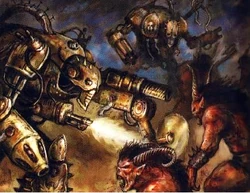
A Legio Cybernetica cohort of Delta-Omega-03 Combat Robots under the command of the Inquisition combats the Daemons of Chaos.
The forces of the Inquisition also put the robot cohorts of the Legio Cybernetica to good use. As robots are believed by their very nature to be utterly incorruptible by Chaos, they make ideal weapons to use against the many enemies of Mankind.
Their pre-programmed, non-biological nature makes them perfect engines of destruction against mutants and other Chaos-contaminated populations. The terror value of robots has not gone unnoticed by the Inquisition, as they are often used against under-prepared and under-armed troops. Combined with their unwavering loyalty, robots have made valuable additions to the Inquisition's forces.
Robot cohorts attached to the Inquisition are usually staffed by their own Technician-Inquisitors rather than a Tech-adept of the Legio Cybernetica, as robots have proved to be pure and incorruptible, whilst men and women are not. This was proven during the dark days of the Horus Heresy.
Notable Imperial Robots
- Incarnadine - Controlled by the Tech-adept Xi-Nu 73, Incarnadine was a Conqueror-class War Robot. Beside its three counterparts, Incarnadine comprised the 9th Maniple of the Carthage Cohort of the Legio Cybernetica. The 9th Maniple was attached to the 1301st Expeditionary Fleet of the Word Bearers Space Marine Legion. This Imperial fleet was commanded by Seventh Captain Argel Tal of the XVII Legion's Serrated Sun Chapter. Incarnadine was the Primus of the 9th Maniple. Almost human in its posture and gait, Incarnadine was armoured with thick platiing and bore weapons for arms. A third cannon rose from its shoulder, with ammunition belts trailing down its back, dreadlocks of bronze shells rattling with each step. It wore a Word Bearers Legion banner over its shoulder, and its armour plating was painted in proud black and scarlet livery and etched with Colchisian runes. A few rare units of the Carthage Cohort had oath parchments and scrolls of scripture bound to their armour plating, marking them as particularly accomplished in battle. These robots, from a variety of classes and designs, were enrolled in the Fidelitas Lex's archives as honorary members of the Word Bearers Legion. Incarnadine was one of them. The robot bore the serrated sun icon of the Serrated Sun Chapter, plated in gold upon its forehead. Such an honour was tantamount to the highest accolades in the Legio Cybernetica, and evidence of the commanding Adept's mastery -- such a machine clearly had a spirit of fierce intensity, and was worthy of recognition. Despite the usual cold indifference paid by the Astartes towards the adepts of the Carthage Cohort, Incarnadine was sincerely respected by the Word Bearers, who reverently referred to the Conqueror Primus as "Brother." But since the robot's induction into the Serrated Sun, and the etching of the chapter's sigil onto the robot's forehead, the Incarnadine had become much more erratic. Even after Xi-Nu 73 purged the robot's cortex, the discrepancies would resurface after each maintenance. This flare of perception, along with the faintest adjustment of its visual receptors, only ever occurred in the presence of the Word Bearers. Like an animal instinctively recognising its kin, Incarnadine knew when warriors of the XVII Legion were near, despite the fact that it should not be able to perceive anything at all beyond the presence of walls and floors. This ability was the first hint that the taint of Chaos enveloping the XVII Legion could affect machines as well as men.
See Also
Sources
- Codex: Adeptus Mechanicus (8th Edition), pg. 42
- Codex: Adeptus Mechanicus - Cult Mechanicus (7th Edition), pp. 21-22
- Codex Titanicus (1st Edition)
- Horus Heresy: Collected Visions (Art Book), pp. 92, 131, 304, 326, 328, 384, 392, 402, 405, 412
- Realm of Chaos: Slaves to Darkness (1st Edition), pg. 240
- The Horus Heresy - Book Three: Extermination (Forge World Series) by Alan Bligh, pp. 212-213, 223, 226
- The Horus Heresy - Book Four: Conquest (Forge World Series) by Alan Blight, pg. 291
- The Horus Heresy - Book Five: Tempest (Forge World Series) by Alan Bligh, pp. 223-227
- The Horus Heresy - Book Six : Retribution (Forge World Series) by Alan Bligh, pg. 274
- The Horus Heresy - Book Seven: Inferno (Forge World Series) by Alan Bligh, pp. 159, 210, 213, 294-295
- The Horus Heresy - Legiones Astartes: Age of Darkness Legions, pp. 22-23
- Warhammer 40,000 Compendium (1st Edition), "Imperial Robots," pp. 67, 96-112
- White Dwarf Weekly 67 (09 May 2015), "Kastelan Robots," "Focus On...Ancient War Machines," pp. 4-12
- White Dwarf 112 (UK), "Adeptus Titanicus: Conqueror! - Robots in Adeptus Titanicus," by Jervis Johnson, pp. 68-72
- White Dwarf 104 (UK), "Chapter Approved: Imperial Robots," by Mike Brunton
- A Thousand Sons (Novel) by Graham McNeill, pp. 101, 103, 107, 115, 246
- First Heretic (Novel) by Aaron Dembski-Bowden, pp. 9, 43, 100-102, 104, 108, 114, 186, 187-193, 195, 203, 234, 236, 425-429
- Nemesis (Novel) by James Swallow, pp. 126-127, 129, 132, 133-136, 138
- Angel Exterminatus (Novel) by Graham McNeill, Chapter One
- The Talon of Horus (Novel) by Aaron Dembski-Bowden, pg. 61
- Forge World - Mechanicum Domitar Battle-Automata
- Forge World - Iron Circle Domitar-Ferrum Battle-Automata
- Forge World - Mechanicum Castellax Battle-Automata
- Forge World - Castellax-Achea Battle-Automata Æther-Flame Cannon Maniple
- Forge World - Castellax Battle-Automata with Darkfire Cannon
- Forge World - Castellax Battle-Automata with Multi-Melta
- Forge World - Castellax-Achea Battle-Automata with Mauler Pattern Bolt Cannon
- Forge World - Castellax-Achea Battle-Automata Mauler Pattern Bolt Cannon Maniple
- Forge World - Castellax Battle-Automata with Multi-Melta
- Forge World - Scyllax-Guardian Battle-Autmata Covenant
- Forge World - Thanatar Siege-Automata
- Forge World - Thanatar-Calix Siege-Automata
- Forge World - Vorax Battle-Automata
- Forge World - Vulturax Stratos Battle-Automata
- Games Workshop Online Store - Adeptus Mechanicus Kastelan Robots




















